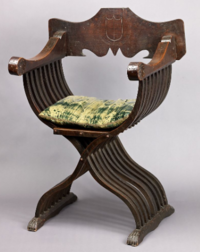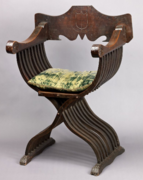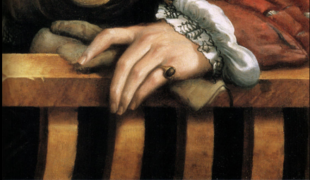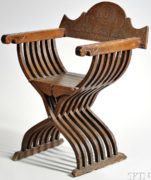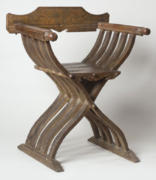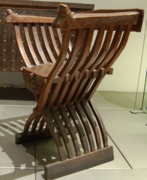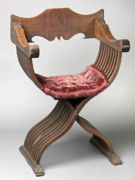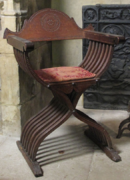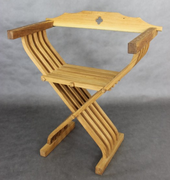Type 2D - Savonarola Chairs
Background:
These are the pinnacle of the X type chairs. The Savonarola has it all: • A portable chair that's solid and stable • Armrests and a back • Has only two pieces (chair and back)
However, it doesn't pack all that flat. Ah, the price of fashion.
Structurally, this is a folding stool, like the Type 2A with the leg assemblies extended high enough to make a comfortable armrest. The Savonarola overcomes the downside noted in the Type 2A description of having wide arms that make the chair unstable, by making them into S curves keeping the width between arms nearly uniform with the width between the feet.
The leg boards are often square in cross-section rather than rectangular. The chairs also have a backboard, often carved that spans the gap between the armrests. The armrests and feet are much thicker and tend to be shaped and/or carved. This gives a much more refined look to the chair.
This evolution of the chair requires more skill to execute well. They were also much more expensive to produce. The legs, rather than plain saw boards, must now be cut out of thicker material to account for the S shape. That doesn't seem like a big deal, but rather than taking standard size boards and ripping them to width, you must acquire thicker stock and carefully cut out the shapes with a turning saw. All of the legs need to be as identical as possible. The stock also needs to be clear of defects with care taken to orient the grain properly to avoid weak spots.
The remaining pieces are similar to the previous types though, as noted, the arms at least were often shaped and sometimes carved. Also, the backboard varied from a small plain board to a large elaborately carved one.
Seating:
Seating is along the X.
Practical Matters:
Possibly the most difficult of the chairs shown here to construct. I attempted to reproduce these earlier in my woodworking career without success. I made a template, cut a little oversize on the bandsaw and then template routed to final form. Some cleanup was still required though. A major mistake was to attempt to make 6 without first exploring the techniques with a prototype. With some help from my squires, we turned 200 board feet of ash into sawdust over several weeks before my will to live expired. After a year or 3 in storage, the 3 best part sets were given to a friend who was interested in attempting to complete them. I think one was eventually assembled, but I haven’t seen it.
After getting all the legs shaped and uniform, you must cut tenons on both ends of each leg. The shoulders of these tenons must absolutely be coplanar to give a good result. Or you could use tenons with no shoulders, but then the walls of the mortises need to be clean and straight.
I would say they are not well suited to production work by an amateur. However, doing one-off work with attention to detail will reward you with a beautiful and sturdy chair.
Construction Notes:
See above on my early attempts on this form. I do not anticipate attempting this form again in the future. It's been done and done well by many many others. I don't see much I can contribute here and it's not a chair I want to own at this point, so I won't be building it.
Common Terms: Scherenstuhl (German), Vouwstoel (Dutch), Sedia Savoranola (Latin)
Gallery of Period Illustrations and Extant Examples
Metropolitan Museum of Art, New York. A 19th Century restoration of a 15th Century chair Src
Detail from the Portrait of Galeazzo Sanvitale (1524), a painting by the artist Parmigianino. Src
Sinner Online Auction Catalog. Walnut chair from Italy, date unknown. Sold for $584 in 2015. Src
Unknown Src
The John Woodman Higgins Armory Collection at the Worchester Museum. Italy 1529, probably walnut Src
Museum fur angewandte Kunst, Cologne, Germany. 15th Century Switzerland. Legs are walnut, feet are oak, back is apple. Src
Metropolitan Museum of Art, New York. Walnut, 15th Century Src
Metropolitan Museum of Art, New York. Walnut, late 15th Century or Early 16th Century. Src
Gallery of Modern Repoductions
Commercial Reproduction from Kokosh's Manufacture. Folding Chair F2. 180€ + Shipping Src
Folding Chairs Home
| Type 1 | Type 1A | Type 1B | Type 2 | Type 2A | Type 2B | Type 2C | Type 2D | Type 2E | Type 3 |
